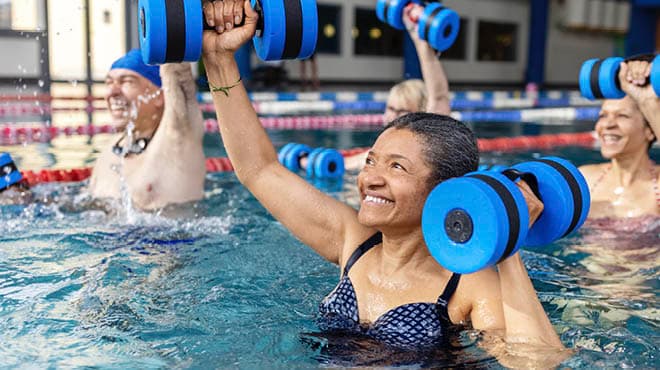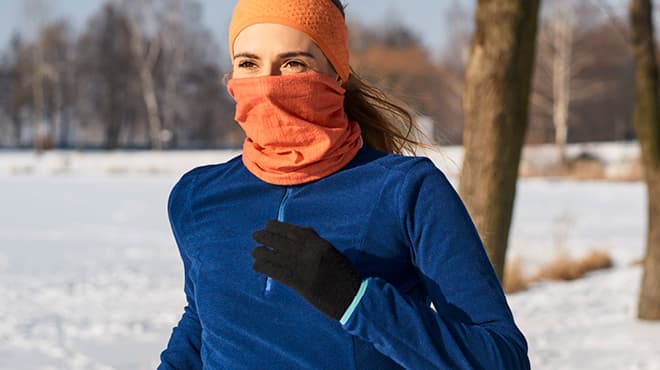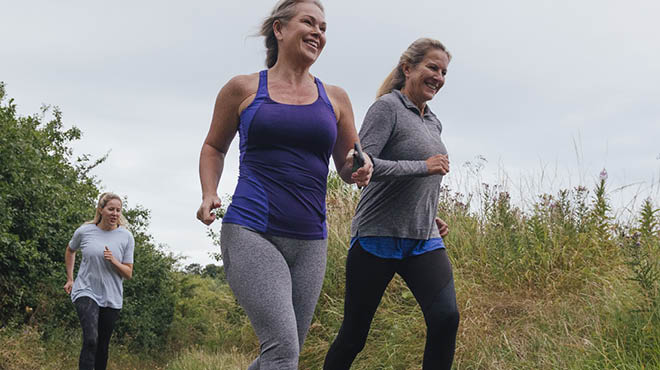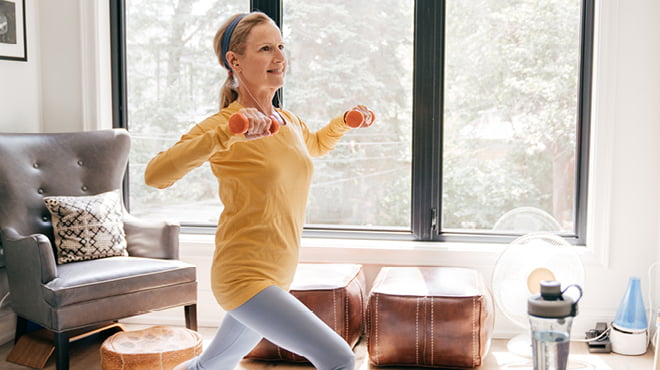Recent Posts
Can a quick workout boost your health and fitness?

When life happens, don't automatically scrap the long workout you had planned for the day. You can still get an effective, full-body workout at home in just 10-15 minutes. Moving more frequently throughout the day is actually better than focusing only on your time at the gym. This type of movement is especially important if you sit for most of the day, since that can cancel out spending an hour at the gym.
Any time you sit for extended periods, blood vessels stiffen and fluids pool in your feet and legs.
Moving your body:
- Boosts your metabolism.
- Enhances the absorption of nutrients.
- Helps control your blood pressure.
- Increases blood flow to the brain for mental health benefits.
- Lubricates joints.
- Makes muscles and ligaments do the work they're designed for.
While exercise is essential for everyone, it's especially crucial as you age.
Moving and exercising:
- Help maintain your strength.
- Improve your coordination and balance.
- Increase musculoskeletal health (strong bones).
- Lessen the chance of falling.
- Promote your range of motion.
What should a 10- to 15-minute workout look like?
It doesn't matter where you exercise. A gym typically offers access to weight and cardio machines and equipment, but you can create similar movements using a space at home. Home equipment may include hand weights, resistance bands and your body weight.
To get the biggest return for your time, target the large muscle groups and select exercises that move more than one joint at a time.
For example, when you do a squat, you work the muscles and joints that help you sit and stand, including:
- Glutes, which make up your buttocks.
- Quadriceps and hamstrings, which run along the front and back of your upper legs.
- Your ankle, knee and hip joints.
Design your workout by choosing exercises that fit into four movement types. This ensures that you target different muscle groups and joints to improve strength across your entire body, not just a single body part.
Click on the link for how-to tips and to view a video:
- Upper body push (push-ups)
- Upper body pull (rowing using hand weights or resistance band)
- Lower body push (squat)
- Lower body pull (lunge)
Start with 5-10 repetitions of each exercise. You can repeat the circuit for 10 or 15 minutes. Consider doing one set in the morning and repeating it later in the day.
Here are more examples for each movement category:
Upper body push
Shoulder press. Hold hand weights between your collarbone and shoulder height with the elbows beneath the wrists. Bracing your core, keep your chest up, and drive the weight upward until your arms are straight and the weights are overhead.
Triceps extension. Bend at the knees and hips and lean forward so that your torso is at a low angle to the floor. With the weights in your hand, pull your elbows back to the side of your torso. While keeping the upper arm and elbows stationary, extend at the elbow to straighten your arm. Slowly return elbows to the bent position.
Upper body pull
Dumbbell shrug. Standing upright, grip a weight in each hand and hold them at your side. Elevate your shoulders in a shrugging motion, then lower them back to the starting position.
Reverse flys. Bend at your hips with a slight bend in your knees so that your torso is almost parallel to the floor. Hold hand weights or a resistance band below your chest, keeping your arms straight down. Lift weights or pull the band to the side so they're perpendicular to your torso by squeezing your shoulders together in the back. With control, lower your arms to the starting position.
Lower body pull
Glute bridge. Lie on the floor with your feet on the ground or low bench and your knees bent. Place your arms out to your side, brace your core to keep your back flat, and drive your feet into the ground or bench. Focus on squeezing the glutes and hamstrings, extending at the hips until your torso and upper body are in a straight line.
Step ups. Stand in front of a sturdy, elevated stepping surface, such as the bottom step of stairs. Step up with one foot, shifting your body weight onto that foot to lift the rest of your body into a standing position on the step. Step off carefully and step up again using the same foot or alternate feet.
Lower body push
Forward lunge. Keeping your torso upright with a slight forward lean, step with one leg forward. Bend the front leg and bring the knee of the back leg to the ground. Contract the front leg to drive your feet into the ground and return to standing. Use hand weights, if desired.
Sumo squats. Stand with feet more than shoulder width apart. Point toes out at a 45-60-degree angle. Lower your body by bending your knees and hips at the same time. Keep your body weight over the middle of your feet and knees in line with your toes. As you stand, keep your knees out and in line with your feet.
Core and full-body
Farmer's carry. Standing up straight, hold a hand weight in each hand. Keeping your arms still, walk forward with controlled, medium-long, heel-toe strides.
Bird dogs. Get down on your hands and knees with your knees positioned below your hips and hands below your shoulders. Reach out one arm overhead; on the opposite side, stretch your leg out behind you. Bring the outstretched arm and leg together beneath your torso, touching the elbow to the knee. Repeat on both sides.
Work your heart and lungs, too
Pair the strength exercises with longer workouts that make your heart and lungs work harder, such as running, walking, cross-country or downhill skiing, snowboarding, ice skating or inline skating, racquet and ball sports, swimming and water fitness, canoeing or kayaking — even climbing stairs or playing a game of tag with the kids.
Make sure to vary the intensity level of your exercise.
On some days:
- Exercise at an intensity that's easy to sustain for more than 30 minutes, and allow you to carry on a conversation.
- Exercise at a higher intensity that you may only be able to sustain for 10-20 minutes and having a conversation is challenging.
The key is to move, have fun with friends and family being active — spending some of that time outdoors — most days of the week.
Workouts that work
Workouts work best when they fit into your routine. You can do a 10-15 minute workout every day or a couple of times a week to supplement longer workouts.
If finding 10 minutes to work out is a challenge, treat your body to an "exercise snack" for 30 seconds. Stand up and sit down, wave your arms above your head, march in place or do a couple of lunges or squats. Both your body and mind will feel more energized.
Next Steps:
- Check out ways to start a weight-training program.
- Consider consulting with a sports medicine specialist.
- Don't forget that walking is good exercise.
- Follow Journey to Wellness for physical and mental health tips.
- Get tips for fitting a workout into your busy day.
- How isometric exercises can control blood pressure.
- Learn why a strong core is important.
- Stuck at your desk? Try these exercises.
Andrew Jagim, Ph.D., is a physician in Sports Medicine in Onalaska, Wisconsin






